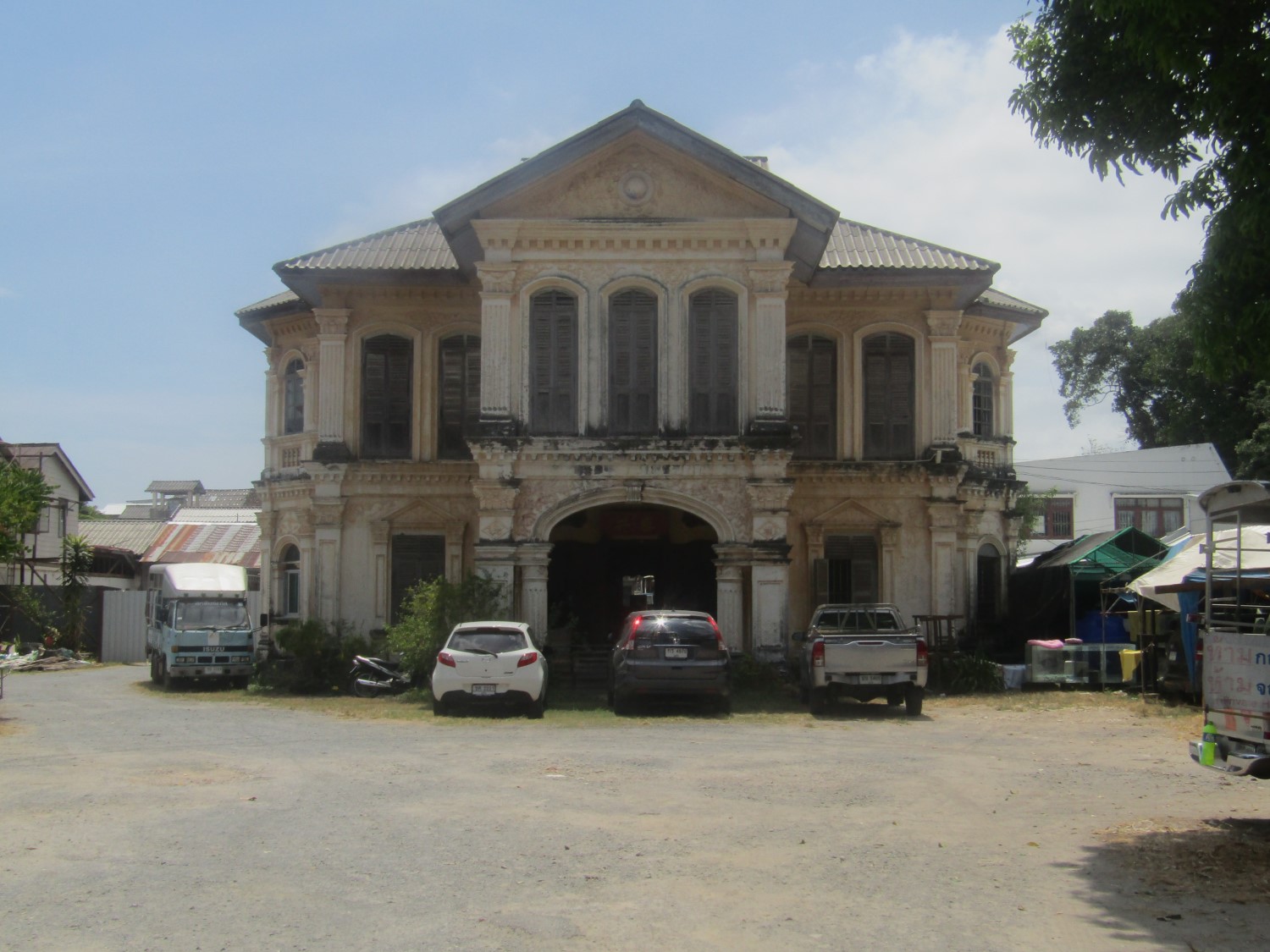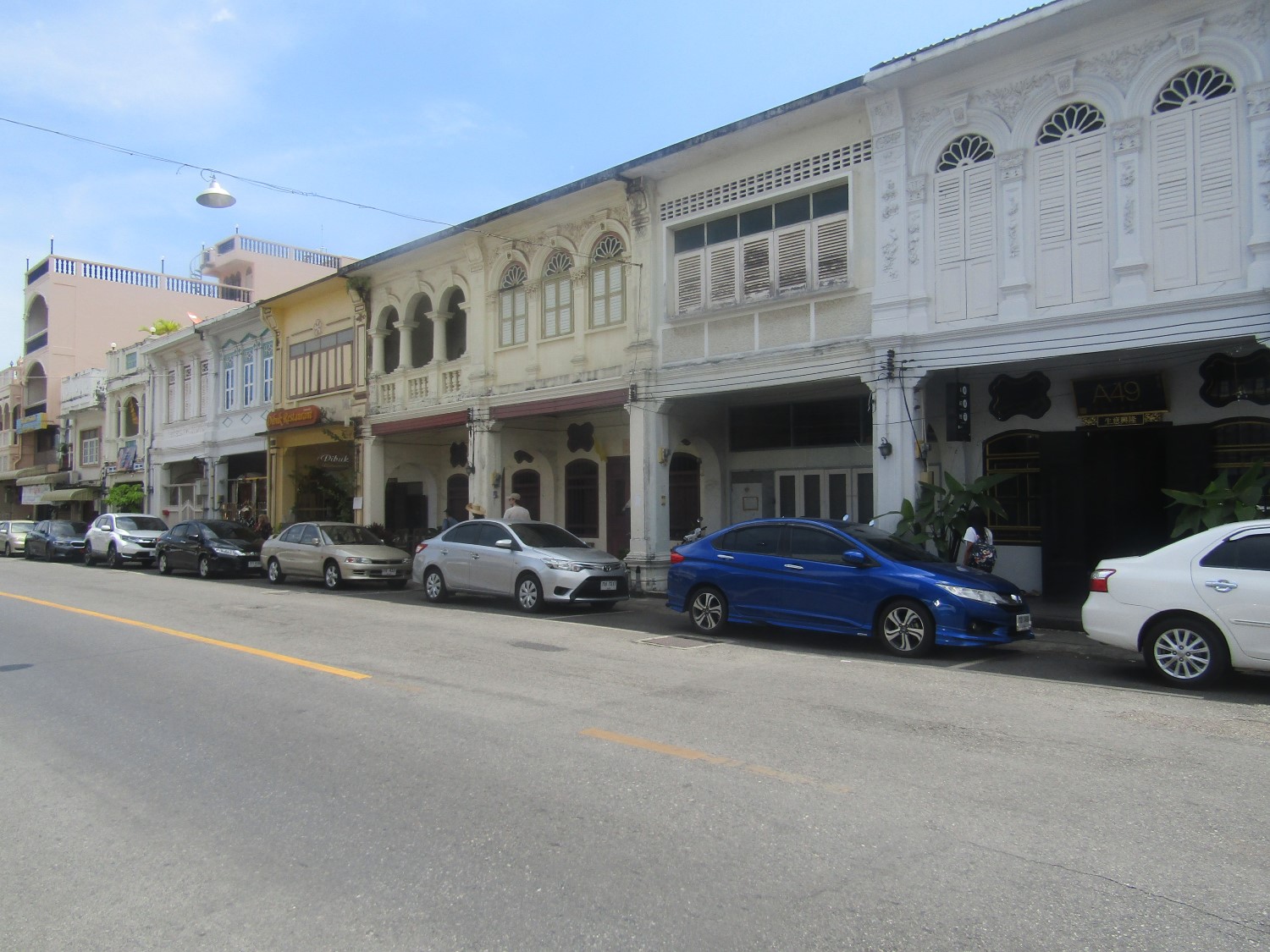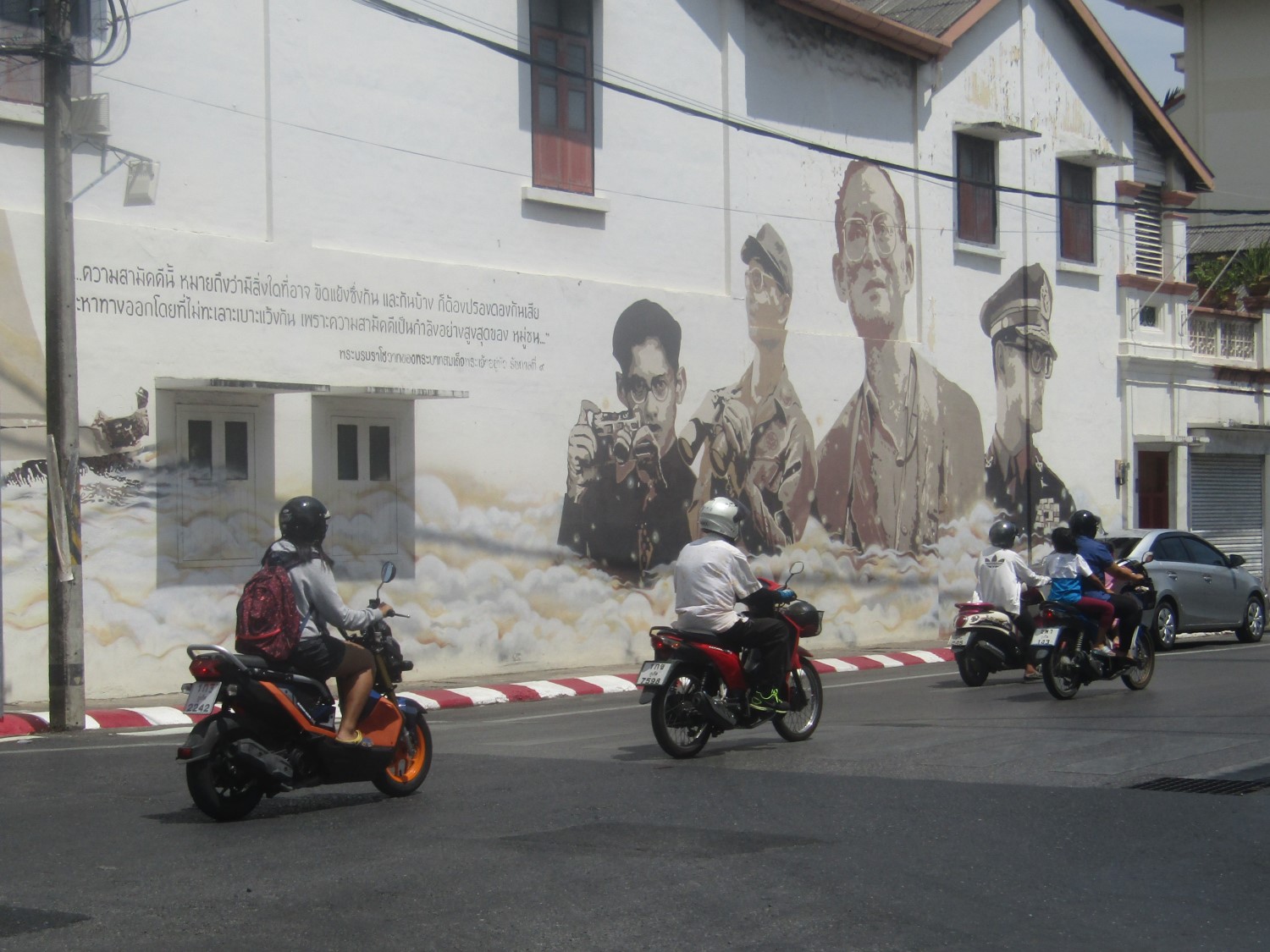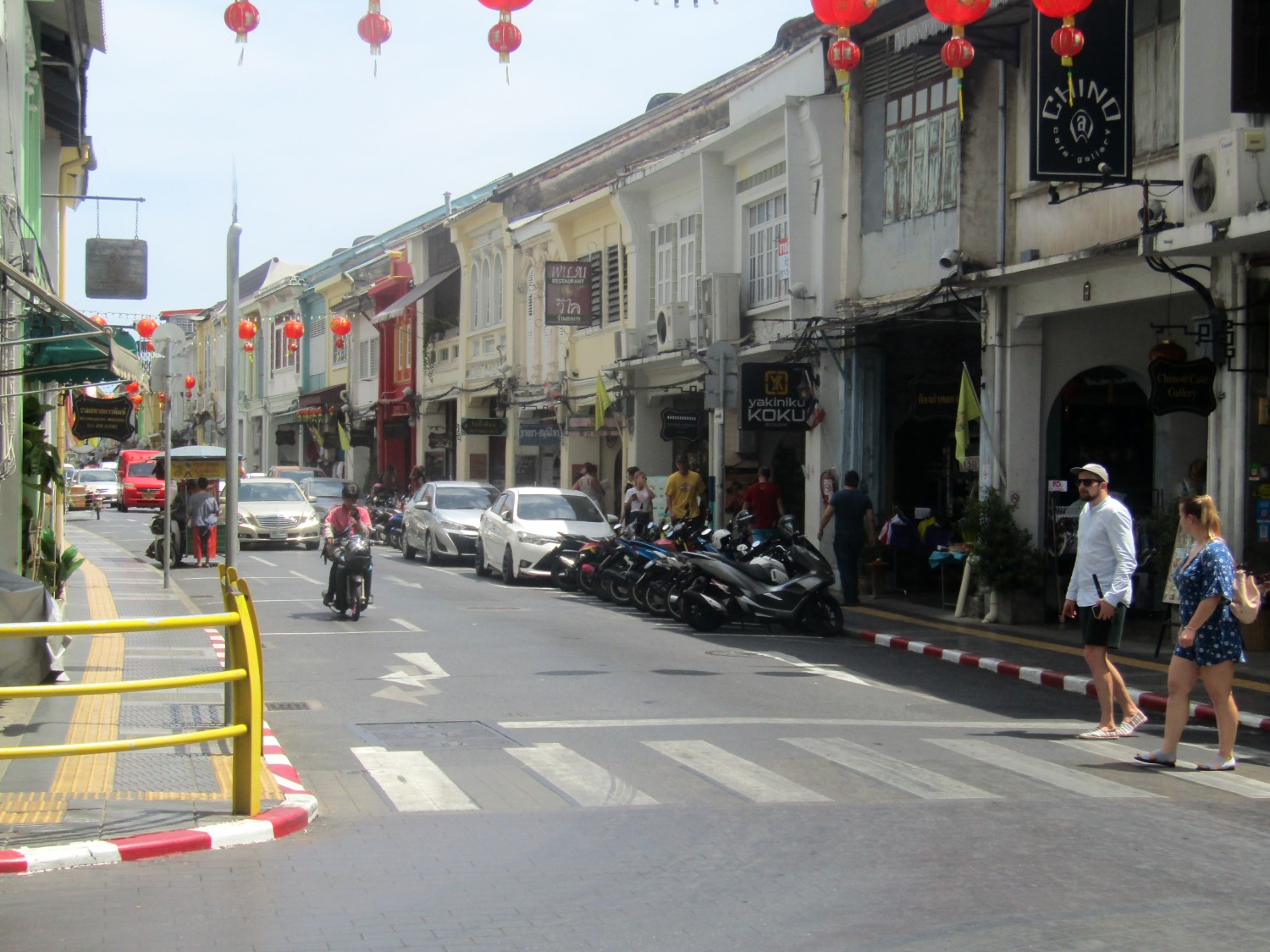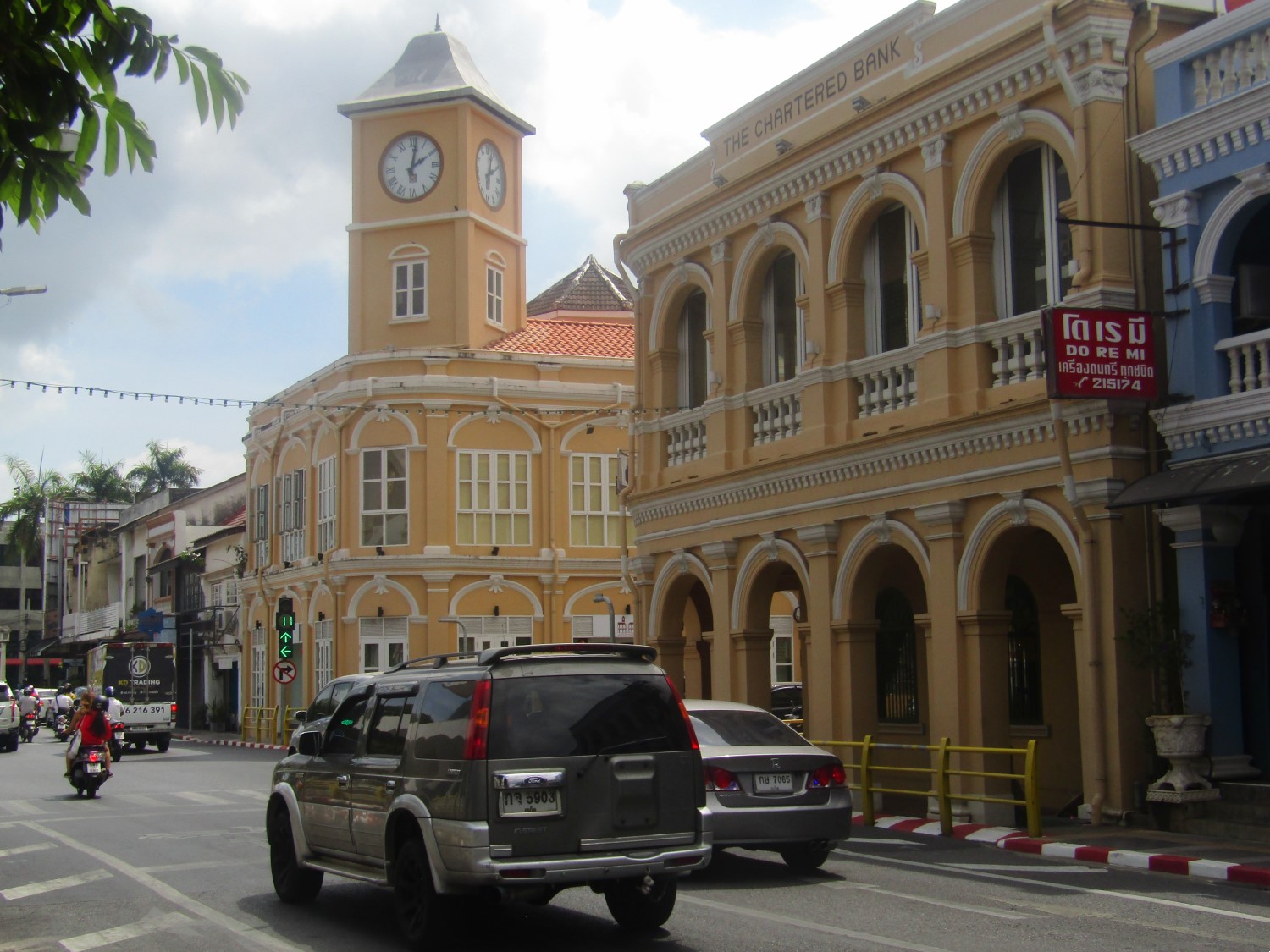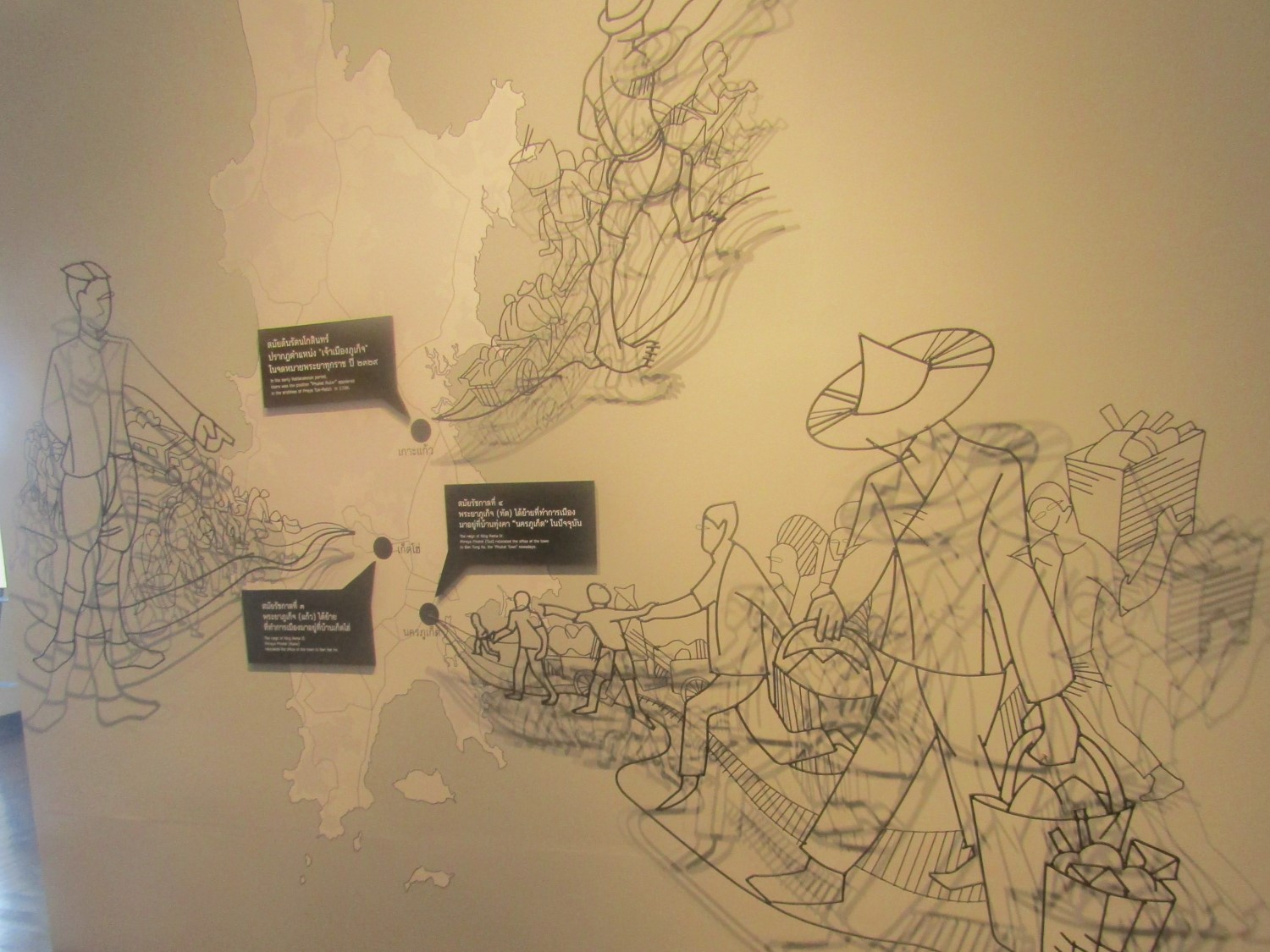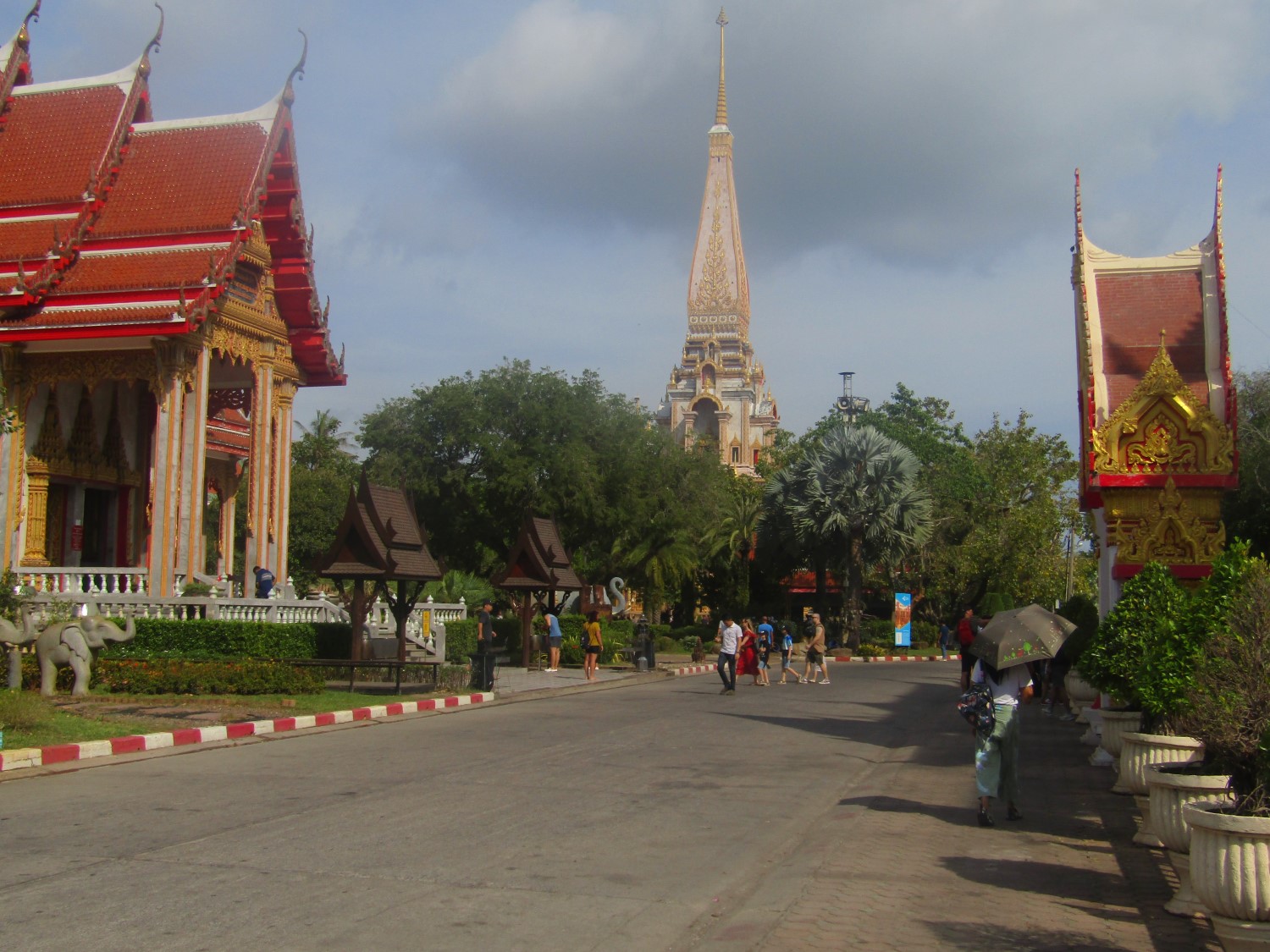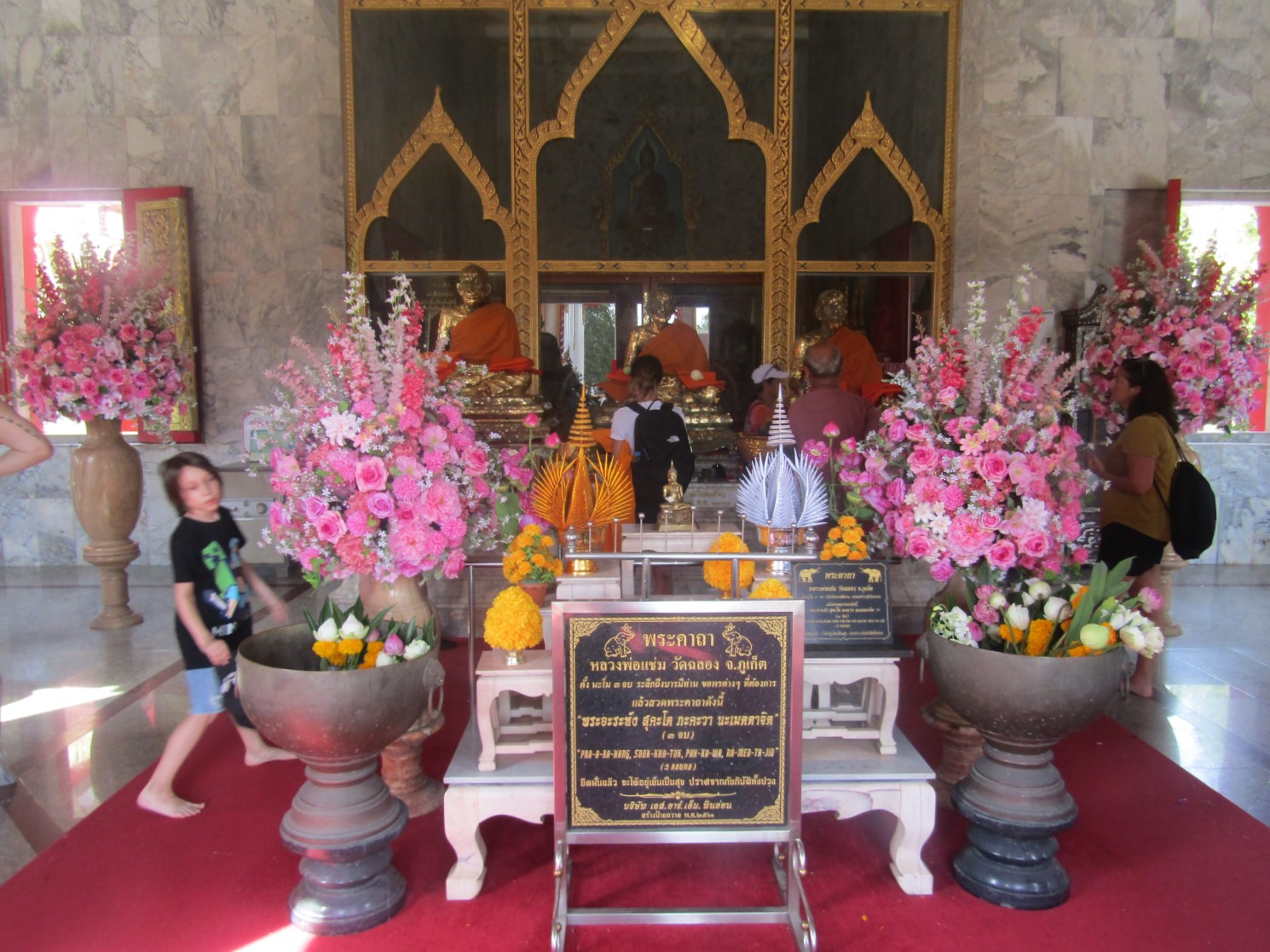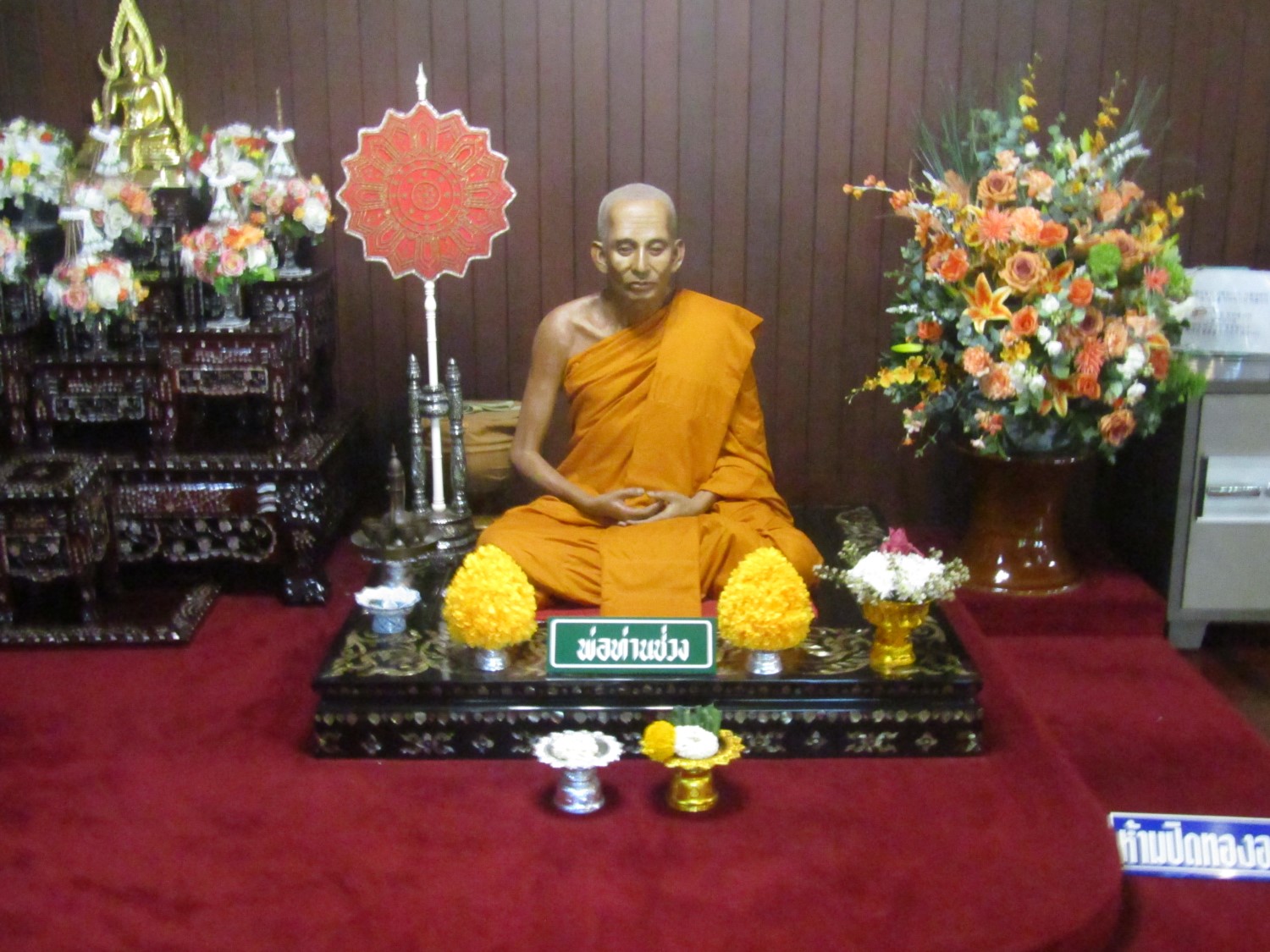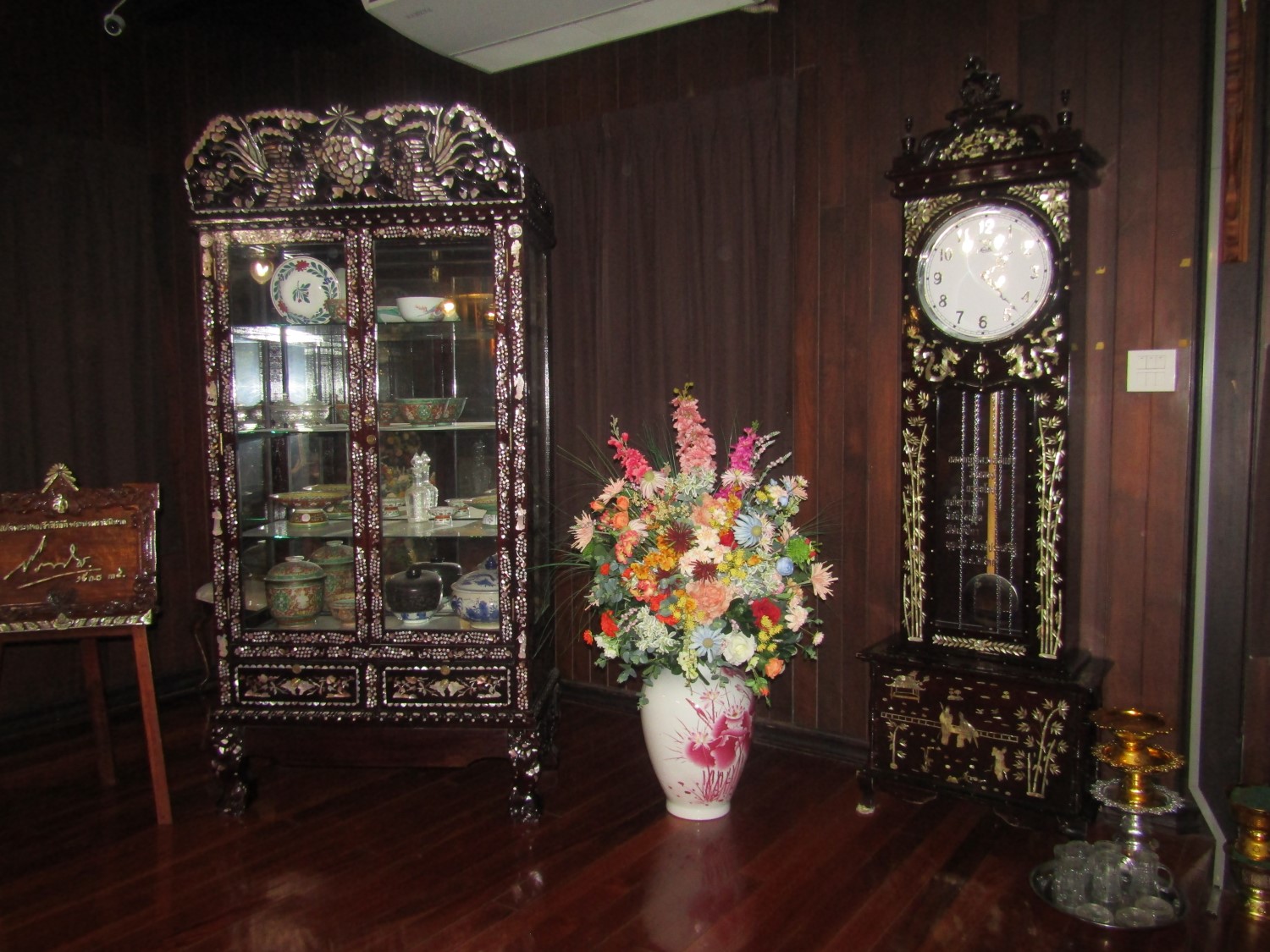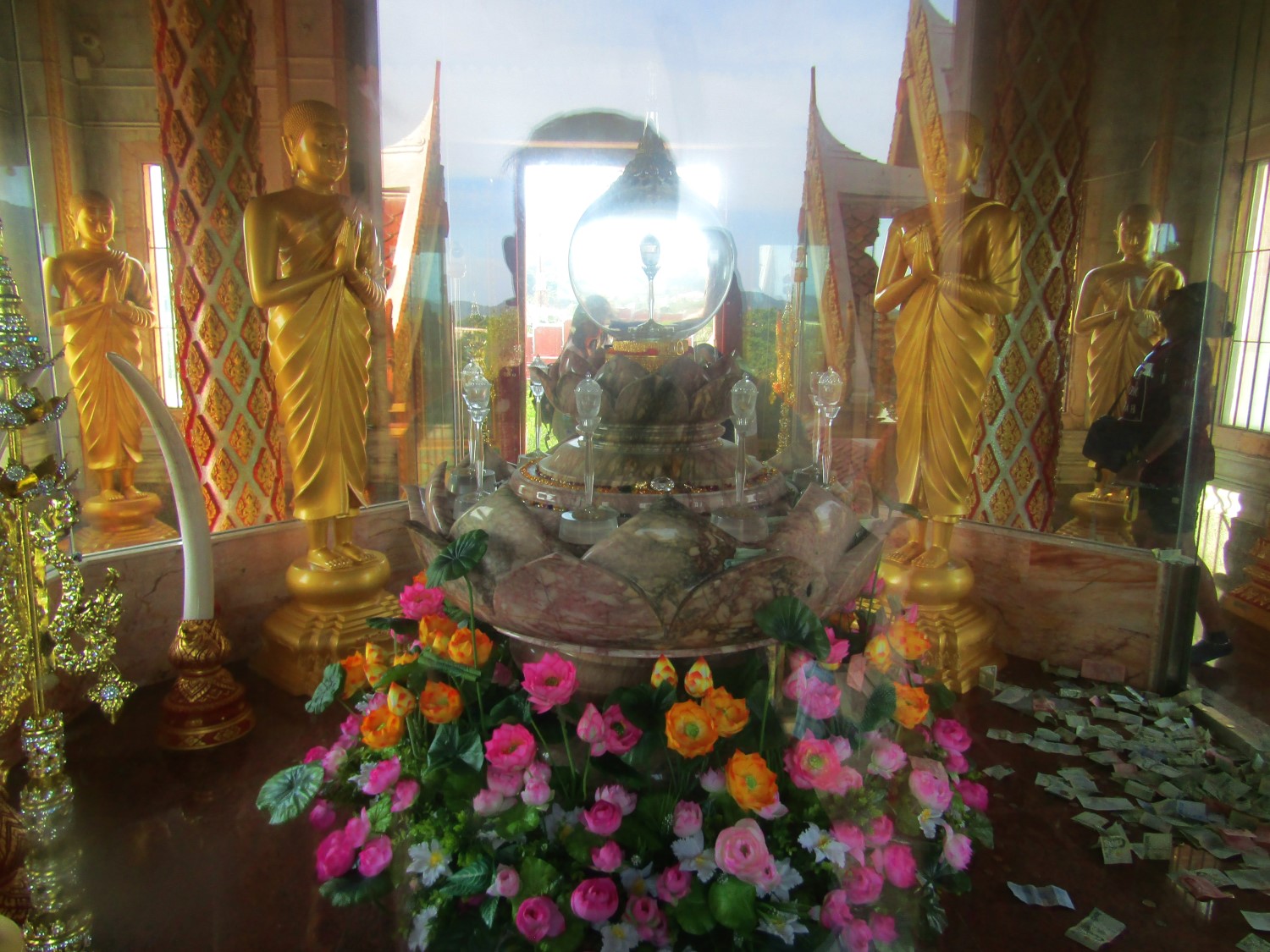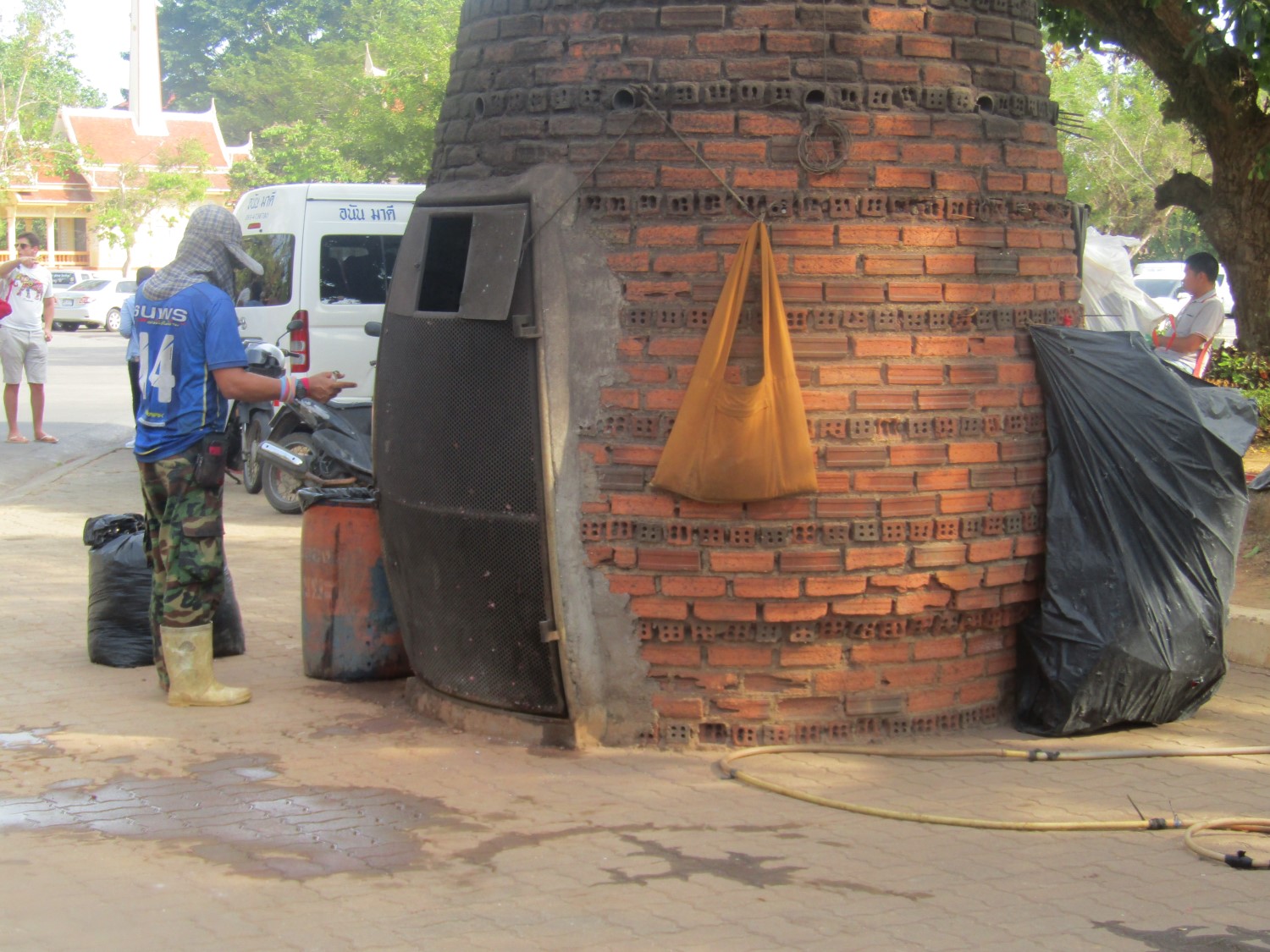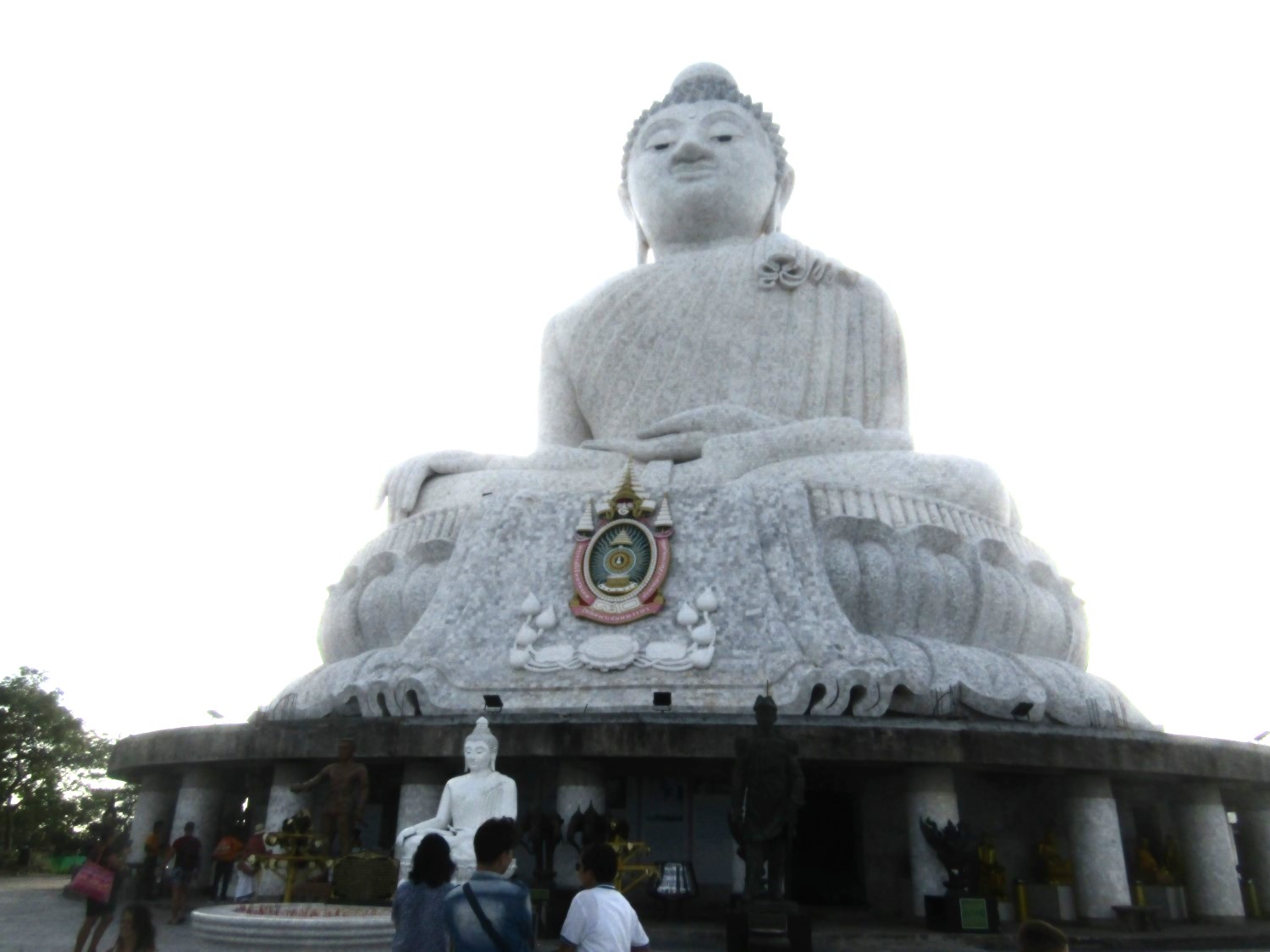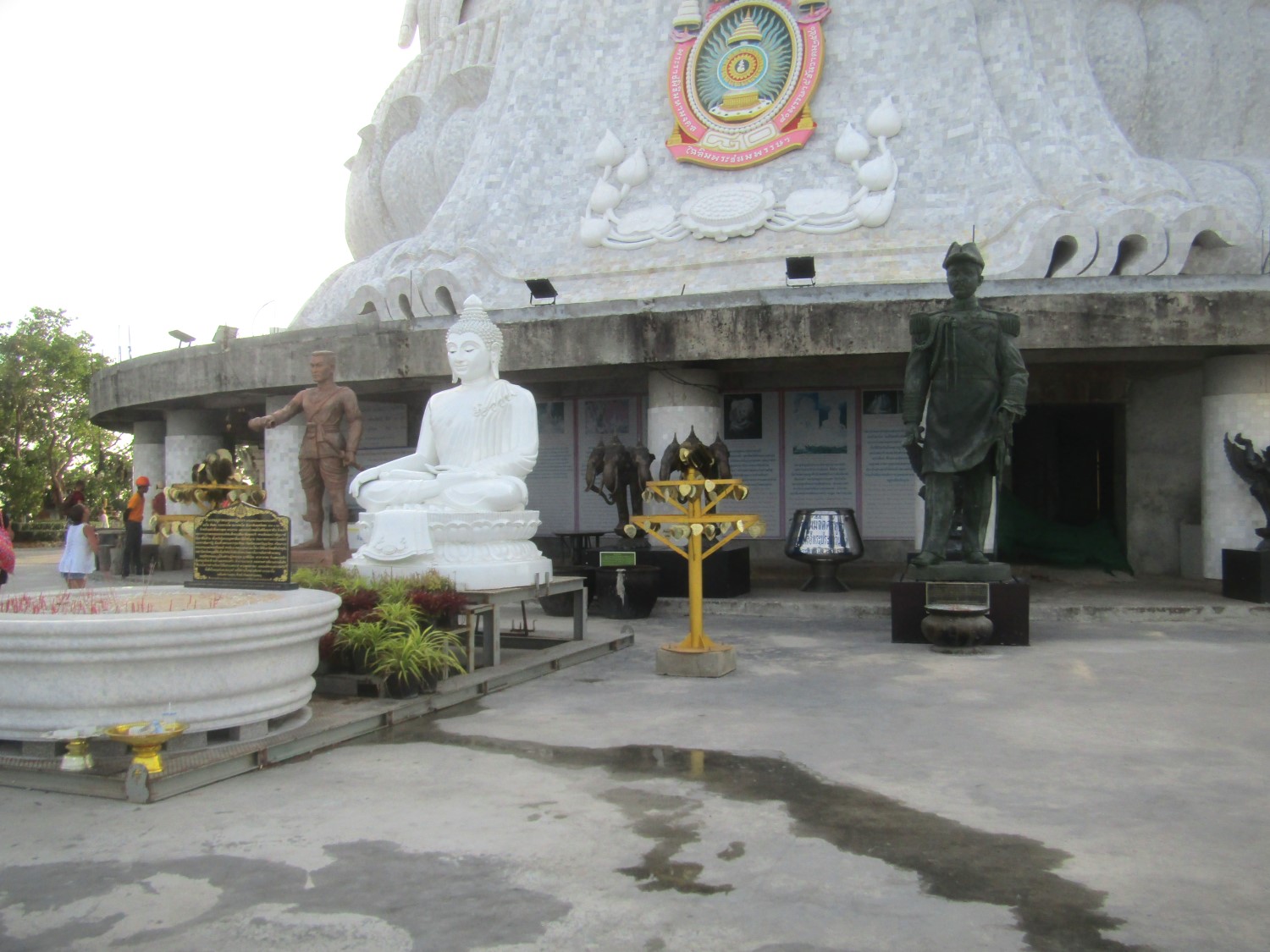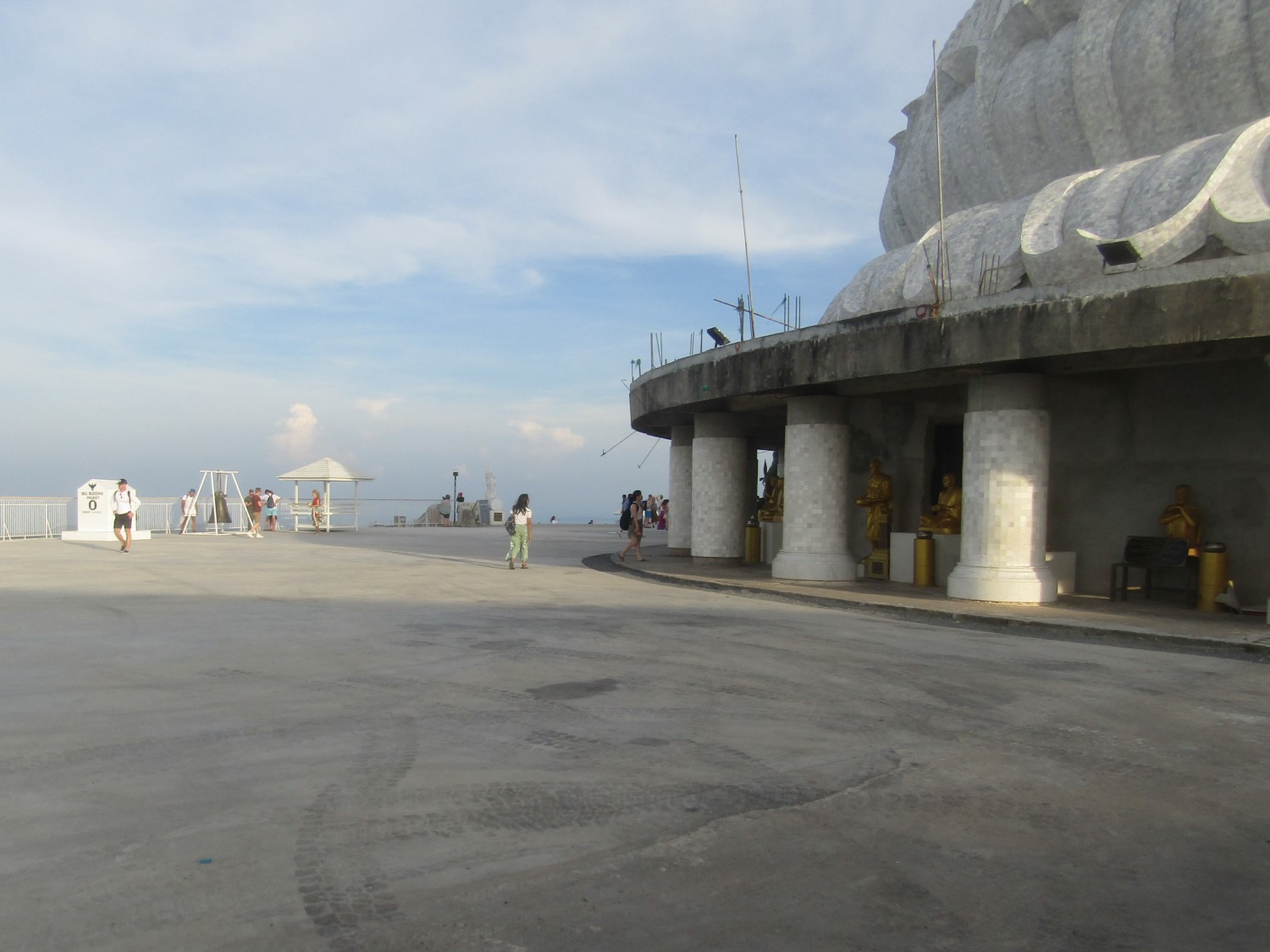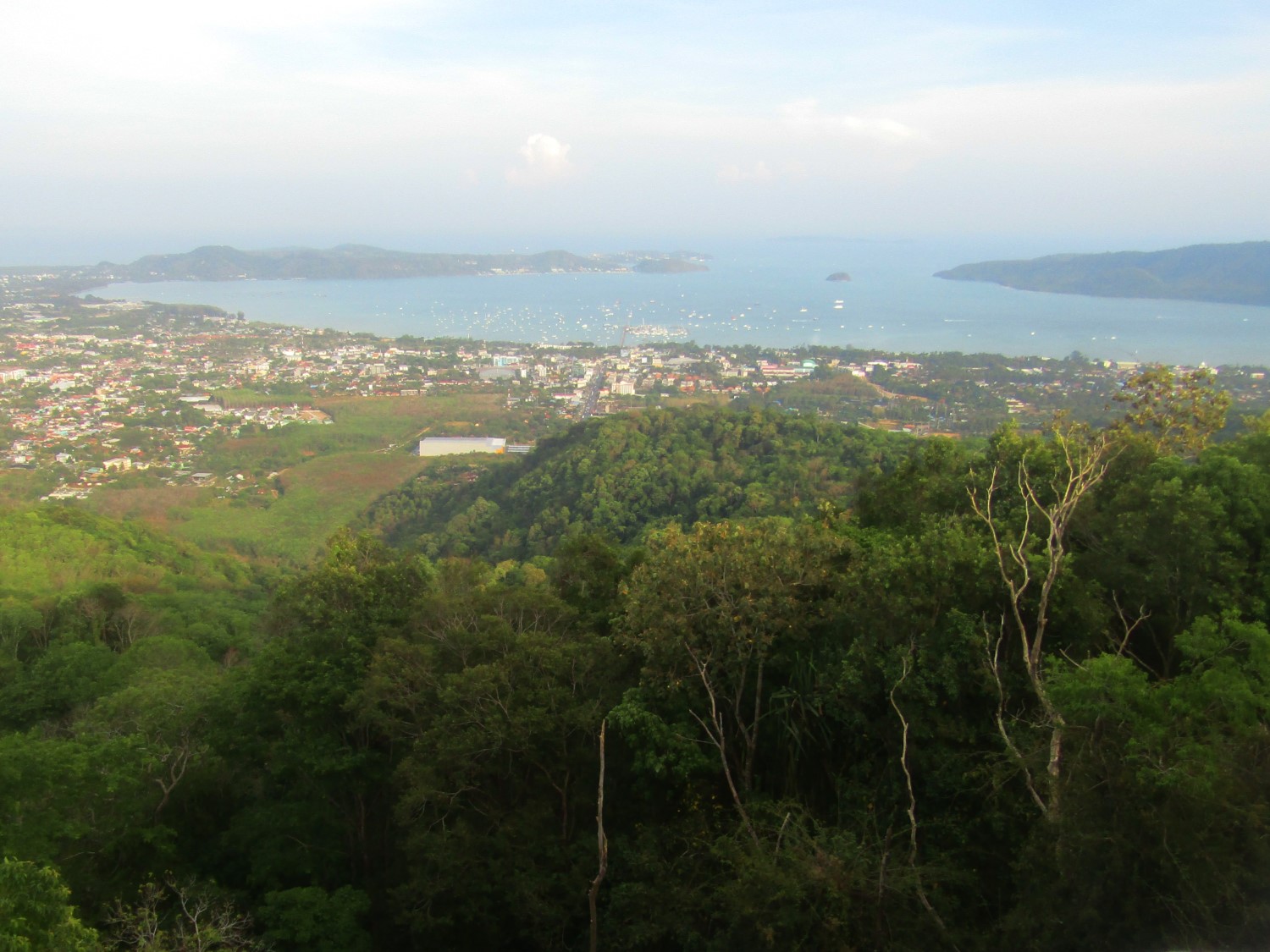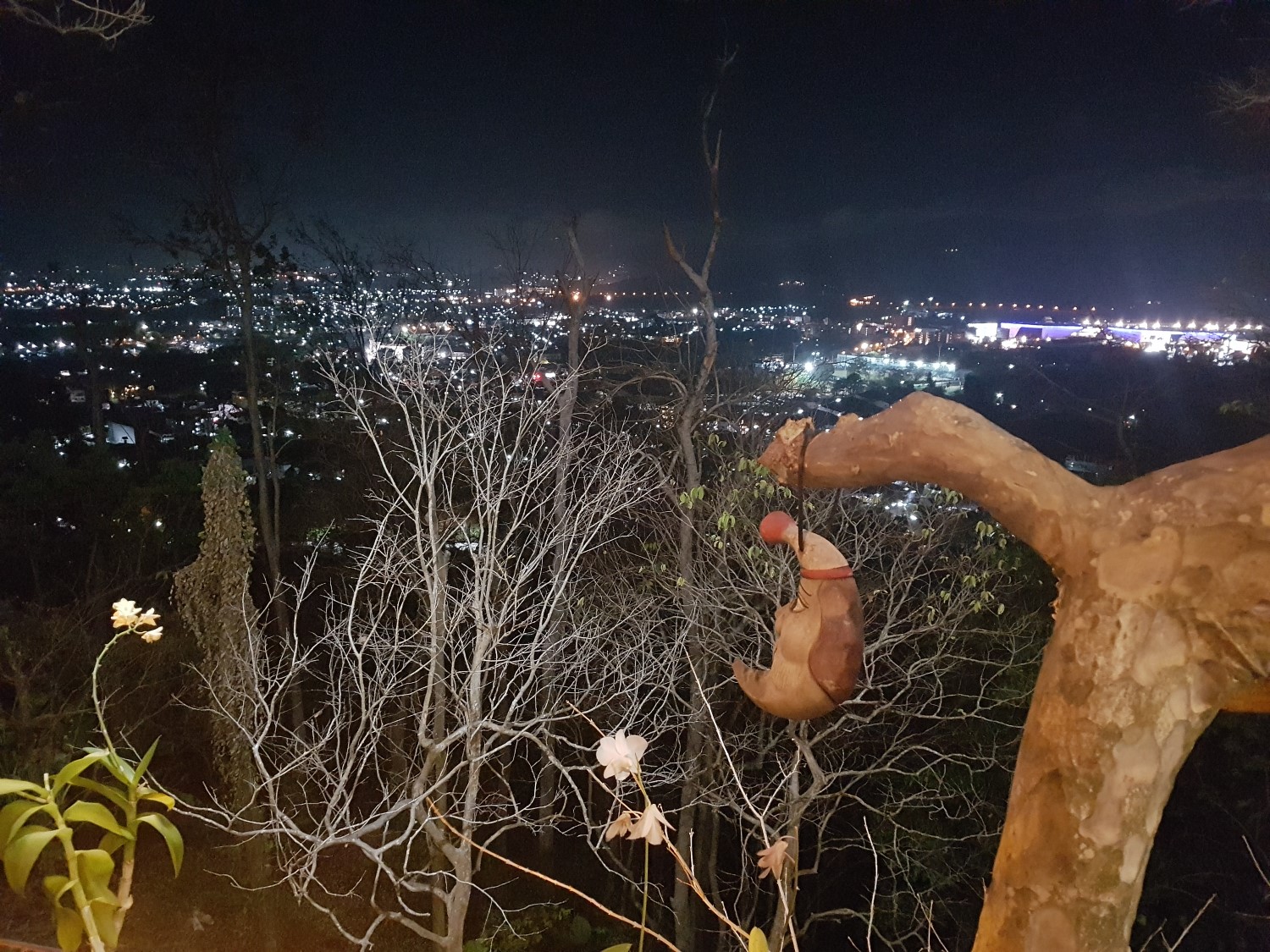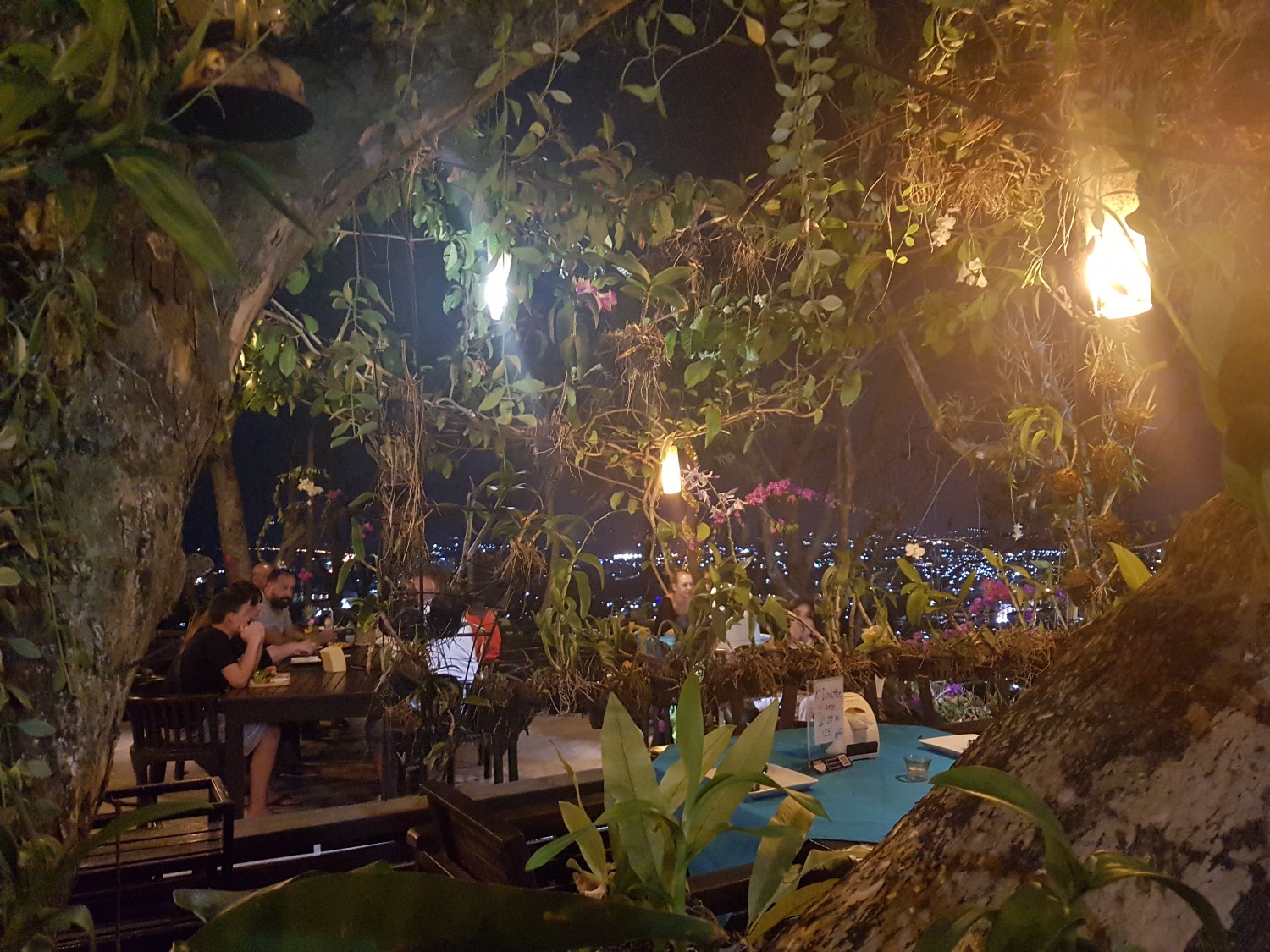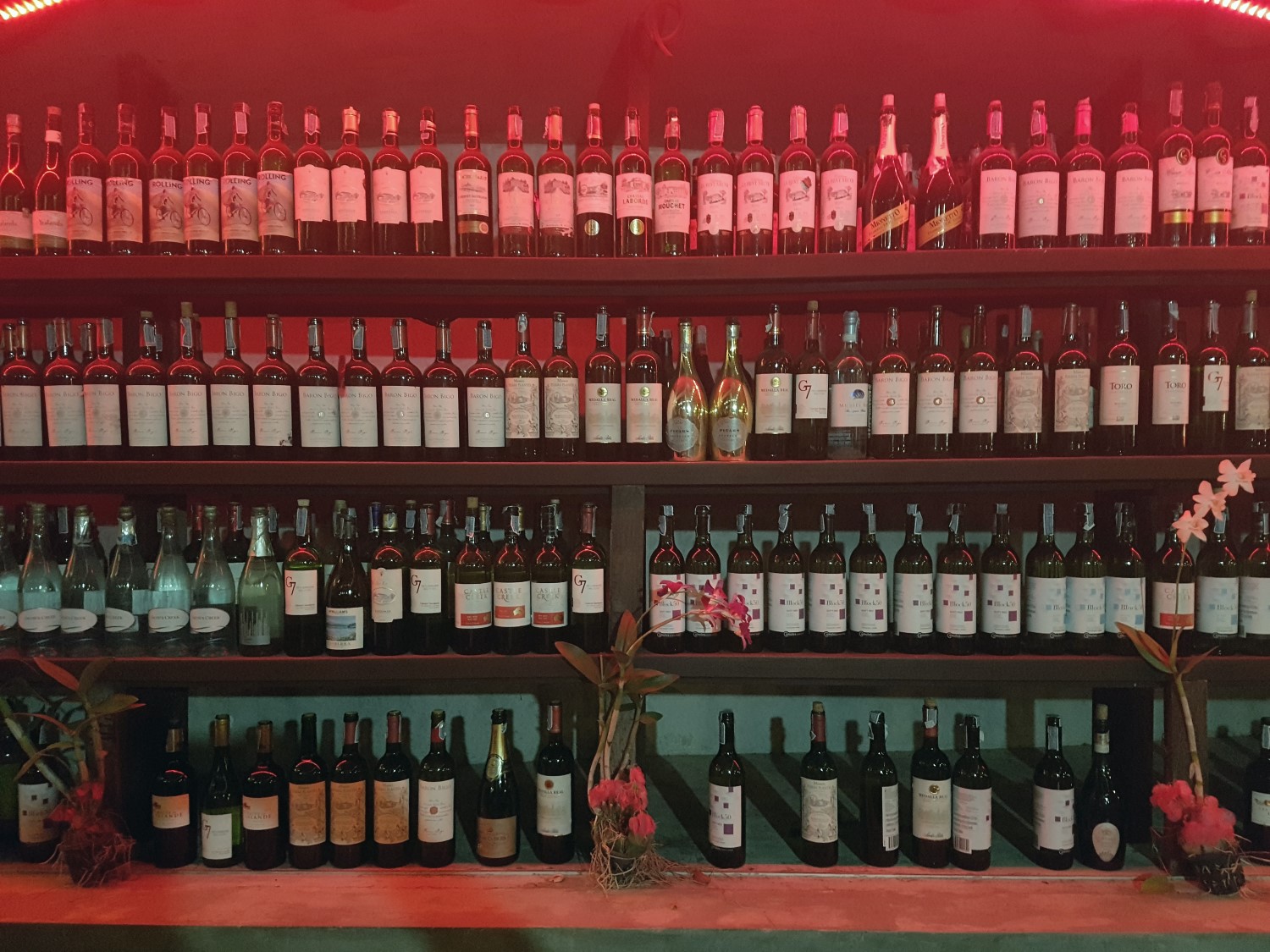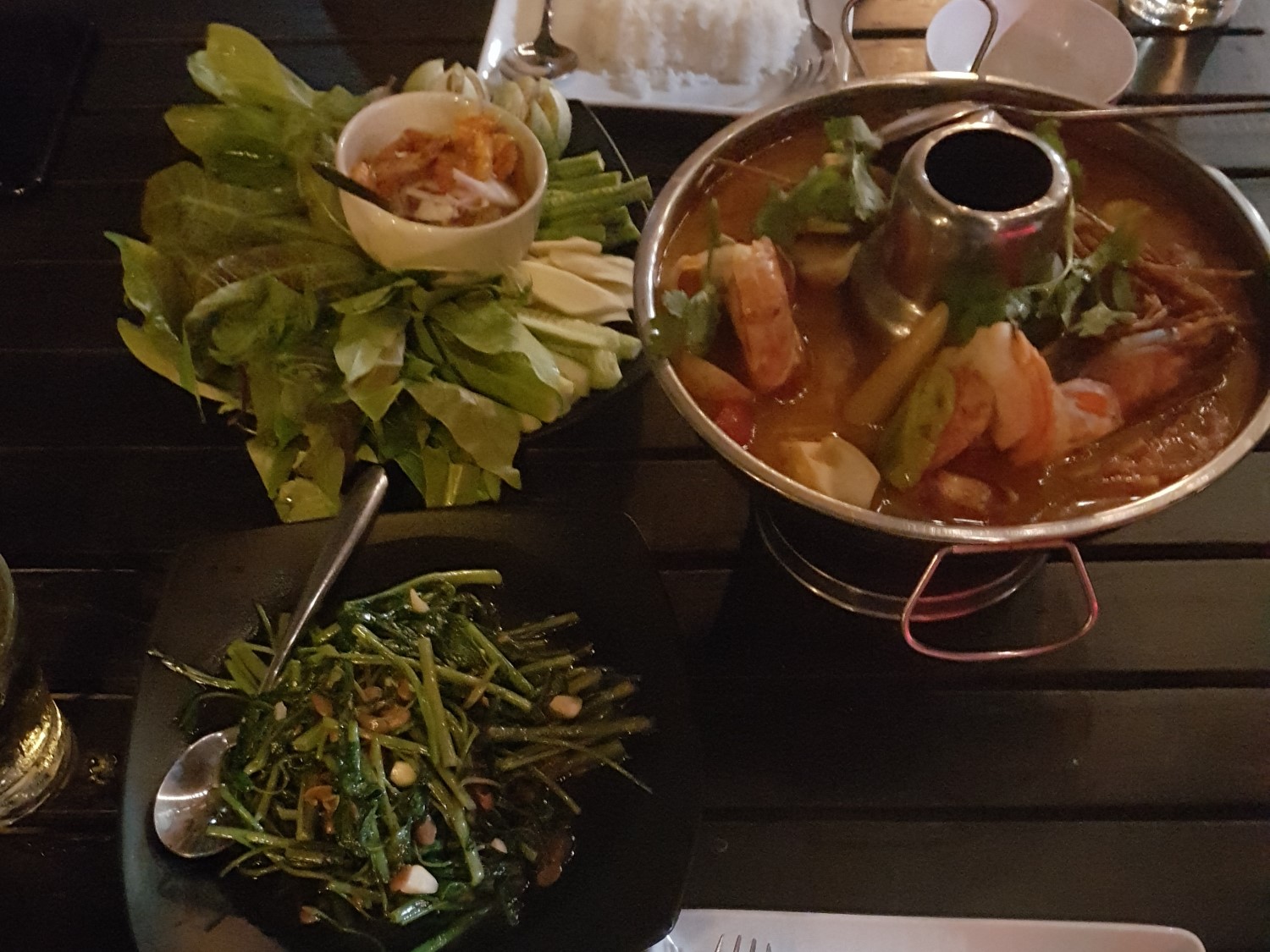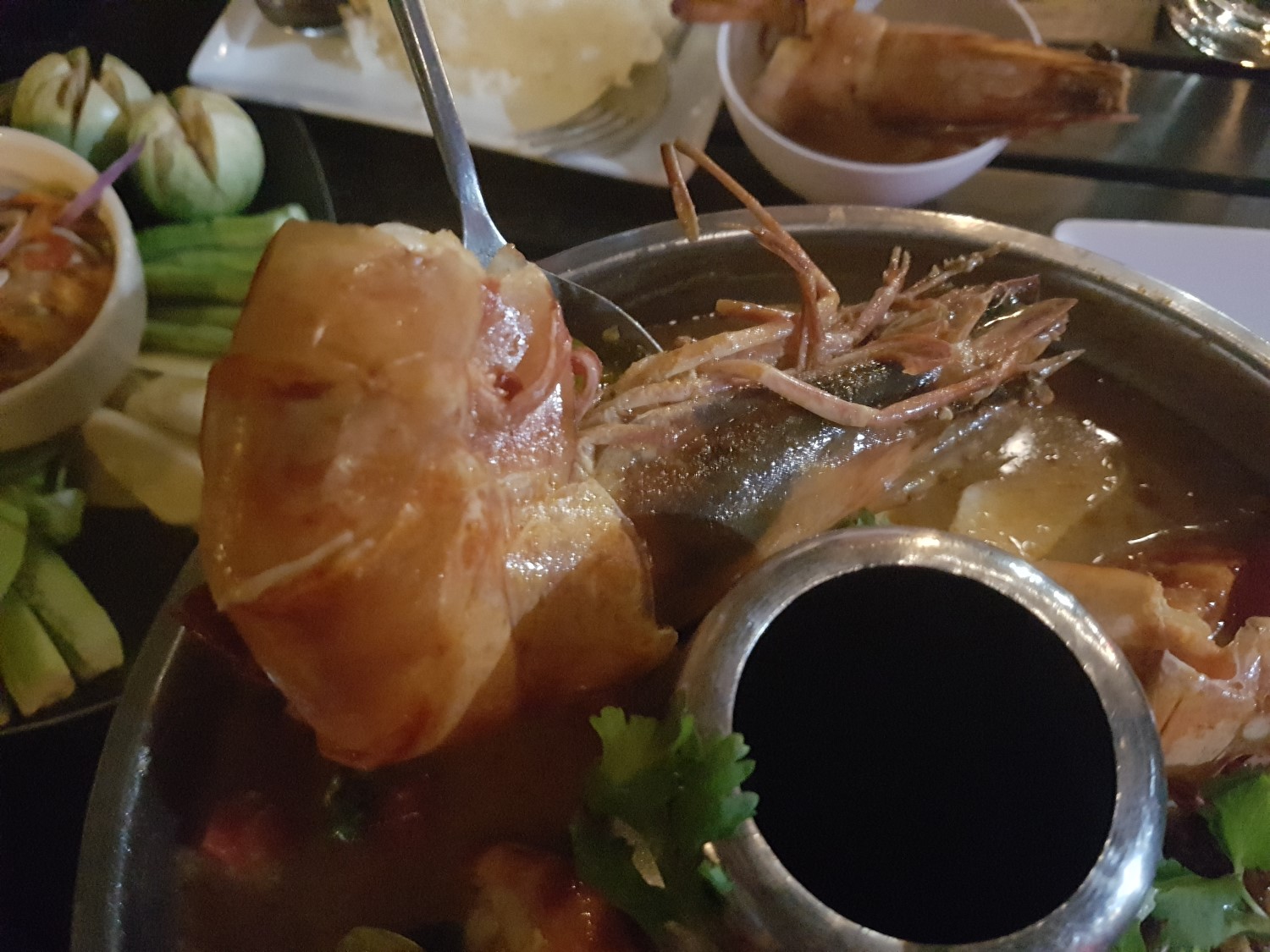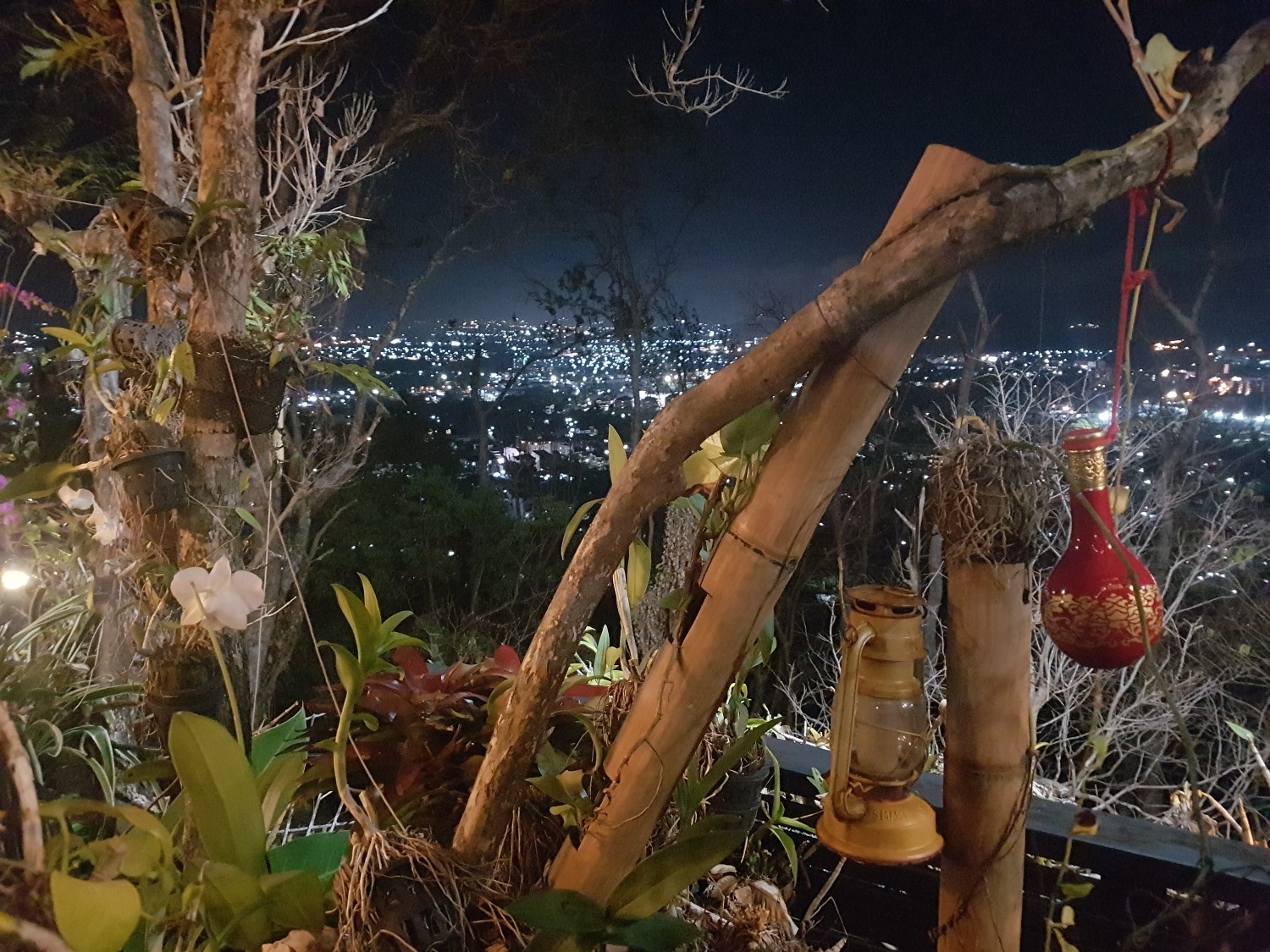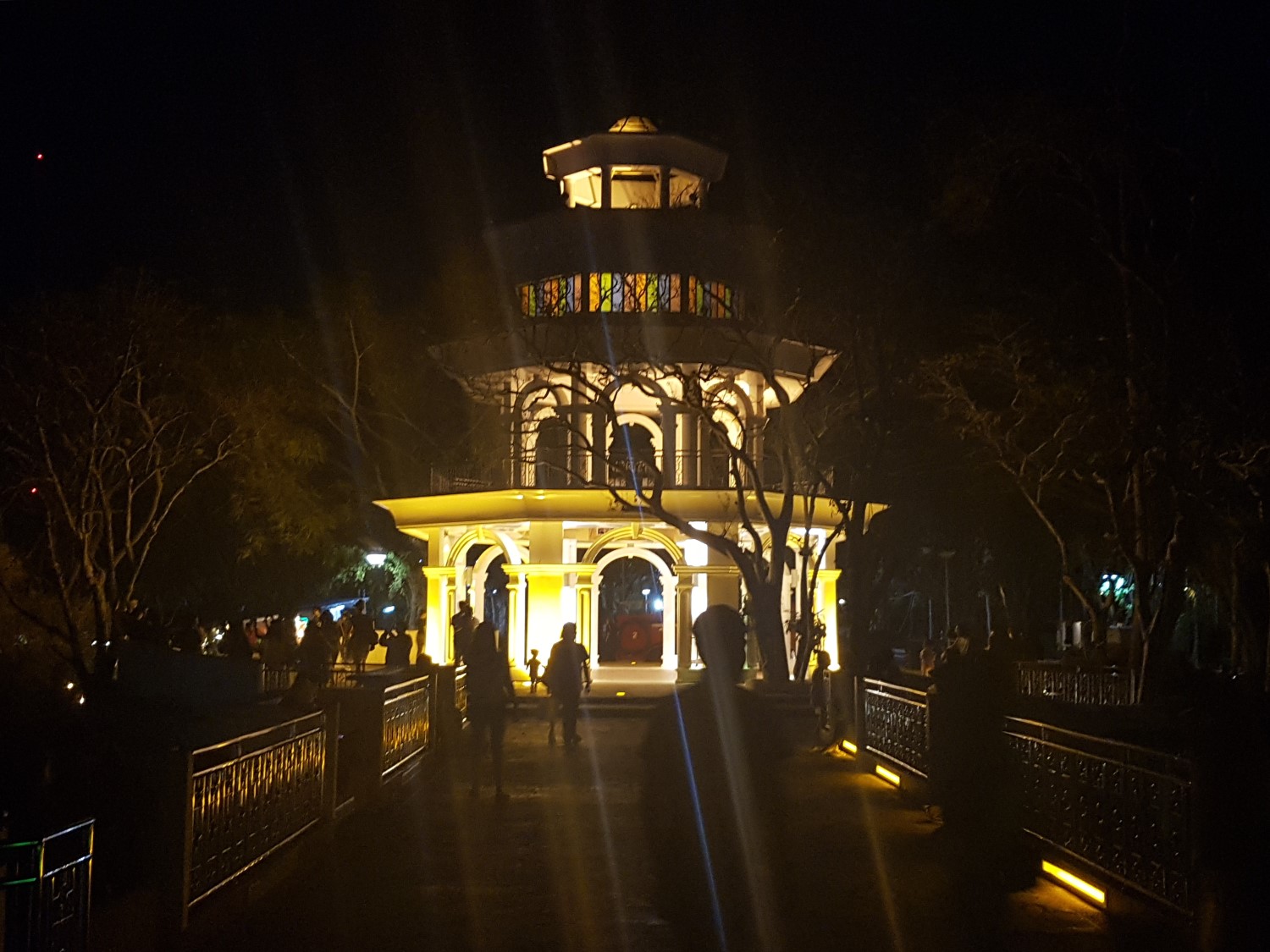
Day 4, Friday 15 February
Attractions…….. Now settled in at Phuketa Hotel, I can make a start bringing my notes up to date. Katoon on the other hand oversleeps and then is in a bit of a panic fearing we will by late for breakfast. In the meantime I contact Ellie to see if we can synchronise visits to meet up again but when that doesn’t materialise we can carry on with our site visits. It’s now down for breakfast which I understand is buffet style.
Arriving later than we would like, we are about the last in the dining area. Then, taking advantage of an amazing spread, we over indulge and that means a prompt start today is now out of the question. However, we will hardly need a lunch now and can continue with our tour till dark at least.
Phuket Old Town…….. With a visit list steadily growing, it’s Katoon, who seems to have developed a liking for Colonial architecture, who heads into the city.
For a community close to the sea, it’s not surprising to find multinational influence. Not surprisingly, as there is in a number of locations in Southeast Asia, the Portuguese set up a trading community here but the town never became developed to any extent until mainly Chinese settlers arrived drawn by the abundance of tin ore in the area. The mining operations continued to develop in the 19th century as a number of Chinese families became very wealthy.
Many signs of family wealth still exist in the town. In a few streets of the old city, Sino-Colonial buildings dominate and these are carefully preserved as a heritage centre and tourist attraction. At the tourist information office in Thalang Road there are heritage maps for guided walks around the old town. The tourist office also doubles as a small heritage museum. Within permitted space they have set up cultural exhibitions related to food and dress.
While we wander around the streets of the old town, time ticks by and I wonder how much progress now can be made now on my latest site visit list but I can’t ignore the history of Phuket despite most of it being less than 200 years old. Reaching the next location reinforces the point.
Phuket Museum…….. The Phuket Museum relates the story of Phuket Town through 4 eras; forest era, mining era, town era and tourist era. These eras saw in a steady population expansion from Portuguese traders, the influx of Chinese immigrants settling as a result of mining operations for the extraction of tin in the 19th century, the expansion of Phuket town and transition to mass tourism.
An interesting aspect here is the amount of economic and political autonomy the settlers had but in the second half of the 19th Century, more control was imposed from Bangkok. During WWI the production of tin was interrupted, then in WWII during Japanese occupation, demand from the Allied Powers ceased causing severe hardship for the people of Phuket. After the war, production of tin resumed, leading to a period of prosperity but the mines eventually closed when new and more productive sources of tin were found.
In every civilisation there seems to be tipping points that alter the dynamics. The Chinese immigration and subsequent direct control of Phuket by the Siamese Government in Bangkok was one of those points. However, if there ever was a turning point in Phuket’s history, it came at the end of the 20th Century with the mass influx of tourism. Since then this has almost drowned out the culture that once existed. Thankfully the museum and tourist centre keeps much if it alive. Unbeknown to many tourists, tradition still exist in the form of the food they eat and the clothes they buy.
The museum is free to enter but during the time of our visit, sections were closed for renovation of the old Chartered Bank building in which part of the museum is located. Referring to the Chartered Bank, there is an interesting story from the time the bank reopened after WWII. They returned to find the safes looted and proceeded to make a claim on the government. This walking tour has taken about 3 hours, more than I expected and knocks on the head any ideas of a whistle stop tour today. The amount of time is necessary to open up the fascinating history of Phuket Town.
Wat Chalong…….. Katoon is intent on driving the tour itinerary today and sets up the next visit to Wat Chalong.
eAccording to onsite information, Wat Chalong or Wat Chai Tararam in Muang District is the most famous temple in Phuket. It houses the statue of the late and highly revered monk, Luang Po Cham. This monk led the people of Phuket to fight against the wealthy immigrant Chinese, who had taken over the town by 1876. The rebellion resulted in the government in Bangkok sending troops to quell the unrest. Afterwards King Rama V appointed Luang Po Cham with the ecclesiastical title of Phra Kru Wiset Wongsacharn. Beside the statue of Luang Po Cham, his other title possessions are displayed in the temple e.g. his walking stick and his painting are located on the second floor of the Kuti (residence) of the abbot too.
Following the rebellion, Bangkok achieved full control of the province of Phuket.
Big Buddha Phuket…….. Try as I might. I’m unable to divert my agenda away from Katoon’s, who is doing all the driving and we end up chasing our tails for a while until we make it up to the new attraction of the Big Buddha Phuket.
The visit to the Big Buddha holds no special interest for me as it has spiritual but no historic significance. Nevertheless, I'm impressed with the amazing views towards to the west.
Phuket's Big Buddha is one of the most important and revered landmarks on the island. The huge image sits on top of the Nakkerd Hills between Chalong and Kata and, at 45 metres tall, can be seen from as far away as Phuket Town and Karon Beach.
The lofty site offers the best 360-degree views of the island, with sweeping vistas of Phuket Town, Kata, Karon, Chalong Bay and more. Reachable via a winding, 6-km road leading from Phuket's main roads, it's a must-visit island destination.
Known among Thais as the Phra Puttamingmongkol Akenakkiri Buddha, the main statue was built in 2004 and is 25 metres across at the base. The whole body is made of reinforced concrete, layered with beautiful Burmese white jade marble that shines in the sun.
In terms of selecting the itinerary today, I’ve drawn a blank but there are still some interesting attractions on the island which now requires me to spend a further night here.
Typically for this day Katoon has the last word too. After heavy demands on my budget just getting here, I’ve spent very little so far today. That’s now about to change.
Khao Rang…….. Khao Rang is a small hill overlooking the city of Phuket. The magnificent views of the city make it a popular attraction for tourists and locals alike. Most just arrive for the sunset and stay to view the glittering lights of the city below from the pavilion and skywalk surrounding the tower. However, Katoon has something else on her mind as well.
Taking dinner in these idyllic surroundings is a must if you have deep pockets. I can only reflect that I didn’t sew mine up but, in all honesty, I rarely get the opportunity to eat enormous lobster prawns, here prepared in a tom yum hotpot. Once again, it’s a very late arrival back at Phuketa Hotel with just enough time left in the day to write up a few notes and add a beer which I refused to indulge in at Khao Rang.
Next Page.
Attractions…….. Now settled in at Phuketa Hotel, I can make a start bringing my notes up to date. Katoon on the other hand oversleeps and then is in a bit of a panic fearing we will by late for breakfast. In the meantime I contact Ellie to see if we can synchronise visits to meet up again but when that doesn’t materialise we can carry on with our site visits. It’s now down for breakfast which I understand is buffet style.
Arriving later than we would like, we are about the last in the dining area. Then, taking advantage of an amazing spread, we over indulge and that means a prompt start today is now out of the question. However, we will hardly need a lunch now and can continue with our tour till dark at least.
Phuket Old Town…….. With a visit list steadily growing, it’s Katoon, who seems to have developed a liking for Colonial architecture, who heads into the city.
For a community close to the sea, it’s not surprising to find multinational influence. Not surprisingly, as there is in a number of locations in Southeast Asia, the Portuguese set up a trading community here but the town never became developed to any extent until mainly Chinese settlers arrived drawn by the abundance of tin ore in the area. The mining operations continued to develop in the 19th century as a number of Chinese families became very wealthy.
Many signs of family wealth still exist in the town. In a few streets of the old city, Sino-Colonial buildings dominate and these are carefully preserved as a heritage centre and tourist attraction. At the tourist information office in Thalang Road there are heritage maps for guided walks around the old town. The tourist office also doubles as a small heritage museum. Within permitted space they have set up cultural exhibitions related to food and dress.
While we wander around the streets of the old town, time ticks by and I wonder how much progress now can be made now on my latest site visit list but I can’t ignore the history of Phuket despite most of it being less than 200 years old. Reaching the next location reinforces the point.
Phuket Museum…….. The Phuket Museum relates the story of Phuket Town through 4 eras; forest era, mining era, town era and tourist era. These eras saw in a steady population expansion from Portuguese traders, the influx of Chinese immigrants settling as a result of mining operations for the extraction of tin in the 19th century, the expansion of Phuket town and transition to mass tourism.
An interesting aspect here is the amount of economic and political autonomy the settlers had but in the second half of the 19th Century, more control was imposed from Bangkok. During WWI the production of tin was interrupted, then in WWII during Japanese occupation, demand from the Allied Powers ceased causing severe hardship for the people of Phuket. After the war, production of tin resumed, leading to a period of prosperity but the mines eventually closed when new and more productive sources of tin were found.
In every civilisation there seems to be tipping points that alter the dynamics. The Chinese immigration and subsequent direct control of Phuket by the Siamese Government in Bangkok was one of those points. However, if there ever was a turning point in Phuket’s history, it came at the end of the 20th Century with the mass influx of tourism. Since then this has almost drowned out the culture that once existed. Thankfully the museum and tourist centre keeps much if it alive. Unbeknown to many tourists, tradition still exist in the form of the food they eat and the clothes they buy.
The museum is free to enter but during the time of our visit, sections were closed for renovation of the old Chartered Bank building in which part of the museum is located. Referring to the Chartered Bank, there is an interesting story from the time the bank reopened after WWII. They returned to find the safes looted and proceeded to make a claim on the government. This walking tour has taken about 3 hours, more than I expected and knocks on the head any ideas of a whistle stop tour today. The amount of time is necessary to open up the fascinating history of Phuket Town.
Wat Chalong…….. Katoon is intent on driving the tour itinerary today and sets up the next visit to Wat Chalong.
eAccording to onsite information, Wat Chalong or Wat Chai Tararam in Muang District is the most famous temple in Phuket. It houses the statue of the late and highly revered monk, Luang Po Cham. This monk led the people of Phuket to fight against the wealthy immigrant Chinese, who had taken over the town by 1876. The rebellion resulted in the government in Bangkok sending troops to quell the unrest. Afterwards King Rama V appointed Luang Po Cham with the ecclesiastical title of Phra Kru Wiset Wongsacharn. Beside the statue of Luang Po Cham, his other title possessions are displayed in the temple e.g. his walking stick and his painting are located on the second floor of the Kuti (residence) of the abbot too.
Following the rebellion, Bangkok achieved full control of the province of Phuket.
Big Buddha Phuket…….. Try as I might. I’m unable to divert my agenda away from Katoon’s, who is doing all the driving and we end up chasing our tails for a while until we make it up to the new attraction of the Big Buddha Phuket.
The visit to the Big Buddha holds no special interest for me as it has spiritual but no historic significance. Nevertheless, I'm impressed with the amazing views towards to the west.
Phuket's Big Buddha is one of the most important and revered landmarks on the island. The huge image sits on top of the Nakkerd Hills between Chalong and Kata and, at 45 metres tall, can be seen from as far away as Phuket Town and Karon Beach.
The lofty site offers the best 360-degree views of the island, with sweeping vistas of Phuket Town, Kata, Karon, Chalong Bay and more. Reachable via a winding, 6-km road leading from Phuket's main roads, it's a must-visit island destination.
Known among Thais as the Phra Puttamingmongkol Akenakkiri Buddha, the main statue was built in 2004 and is 25 metres across at the base. The whole body is made of reinforced concrete, layered with beautiful Burmese white jade marble that shines in the sun.
In terms of selecting the itinerary today, I’ve drawn a blank but there are still some interesting attractions on the island which now requires me to spend a further night here.
Typically for this day Katoon has the last word too. After heavy demands on my budget just getting here, I’ve spent very little so far today. That’s now about to change.
Khao Rang…….. Khao Rang is a small hill overlooking the city of Phuket. The magnificent views of the city make it a popular attraction for tourists and locals alike. Most just arrive for the sunset and stay to view the glittering lights of the city below from the pavilion and skywalk surrounding the tower. However, Katoon has something else on her mind as well.
Taking dinner in these idyllic surroundings is a must if you have deep pockets. I can only reflect that I didn’t sew mine up but, in all honesty, I rarely get the opportunity to eat enormous lobster prawns, here prepared in a tom yum hotpot. Once again, it’s a very late arrival back at Phuketa Hotel with just enough time left in the day to write up a few notes and add a beer which I refused to indulge in at Khao Rang.
Next Page.
